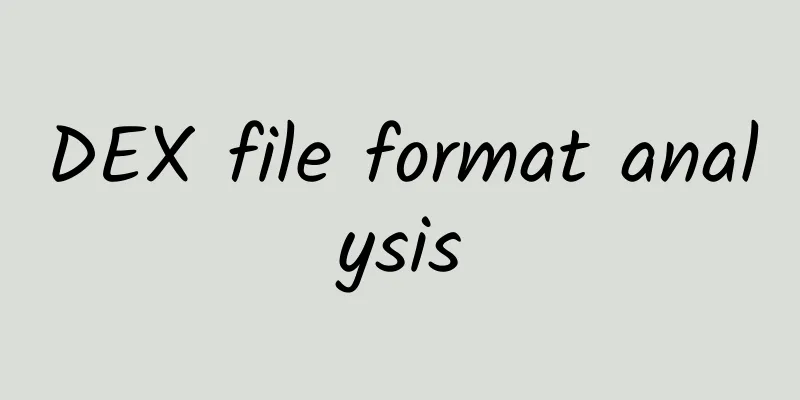DEX file format analysis

|
I was busy cracking the apk of China Mobile and China Telecom some time ago, and I haven't updated my blog for a long time. Recently, I am writing a tool, the main function of which is to hide the types, functions, and attributes in the dex file through configuration to prevent static analysis. Therefore, before writing the tool, you must have a clear understanding of the dex file format. Compared with the elf file format, the dex file format is simpler. Original link: DEX file format analysis 0x00 Introduction The best way to analyze the dex file format is to find an introduction document, write a simple demo and then use 010Editor to analyze it. You can refer to the official document http://source.android.com/devices/tech/dalvik/dex-format.html. If you are not good at English, you can also find a Chinese one, like me. . . . . . 010Editor is a good tool. I used it to analyze elf files before. In fact, as long as you install the template, you can analyze many files. Although it is a paid software, there is a 30-day free trial. But if you are using a Mac 😏 The trial period is over, delete this file 🙄 ~/.config/SweetScape/010 Editor.ini. 0x01 File Layout The dex file can be divided into three modules: header file, index area (xxxx_ids), and data area (data). The header file describes the distribution of the entire dex file, including the size and offset of each index area. The ids in the index area is the abbreviation of identifiers, which indicates the identification of each data. The index area mainly points to the offset of the data area. In 010Editor, except for the data area, all other sections are displayed. In addition, link_data is defined as map_list in the template. 0x02 header The header describes the dex file information and the indexes of other areas. 010Editor (it is a bit troublesome to write 010Editor, so just write 010 below) uses the structure struct header_item to describe the header. There are two data types used, char and uint. The char here is the char in C/C++, which occupies 8 bits, and the char in Java, which occupies 16 bits. There is a little difference, but we can use it to represent short/ushort. This will be introduced in the tool I wrote recently. The official document defines it in ubyte, so let's follow the official one. Structure description:
Except for magic, checksum, signature, file_size, endian_tag, and map_off, all other elements appear in pairs. _off indicates the offset of the element, and _size indicates the number of elements. The remaining 6 descriptions are mainly the information of the dex file.
There is a line break in the middle, followed by 035, which is the version number.
0x03 string_ids The string_ids section describes all the strings in the dex file. The format is very simple with only one offset, which points to a string in the string_data section: The above description mentions the LEB128 (little endian base 128) format, which is an indefinite length encoding method based on 1 byte. If the highest bit of the first byte is 1, it means that the next byte is needed to describe it, until the highest bit of the last byte is 0. The remaining bits of each byte are used to represent data, as shown in the following table. In practice, LEB128 can only reach a maximum of 32-bit, which can be seen by reading the Leb128.h source code in dalvik. The data structure is:
The data stores the string value. string_ids is the most important part, and many subsequent sections directly point to the index of string_ids. When writing tools for comparison, you also need to extract string_ids. 0x04 type_ids The type_ids section indexes all data types in the dex file, including class types, array types, and primitive types. The element format in the section is type_ids_item, and the structure is described as follows:
The value of descriptor_idx in type_ids_item means the index number in string_ids, which is the string used to describe this type. 0x05 proto_ids proto means method prototype, which represents the prototype of a method in Java language. The elements in proto_ids are proto_id_item, and the structure is as follows:
0x06 field_ids The filed_ids section contains all the fields referenced by the dex file. The element format of the section is field_id_item, and the structure is as follows:
0x07 method_ids method_ids is the last entry in the index area, describing all methods in the dex file. The element format of method_ids is method_id_item, and the structure is very similar to fields_ids:
0x08 class_defs The class_def section is mainly for class definition. Its structure is very complicated, and I feel a little dizzy when I read it. Let's take a look at the structure diagram of 010: It makes me dizzy just looking at it, let alone analyzing it. class_def_item The class_def_item structure is described as follows:
type_list type_list is in the data section, class_def_item->interface_off refers to the data here. The data structure is as follows:
annotations_directory_item The data section pointed to by class_def_item->annotations_off defines the data description related to annotation. The data structure is as follows:
class_data_item class_data_off points to the class_data_item structure in the data area. class_data_item stores various data used by this class. The following is the structure of class_data_item:
class_data_item
The following are descriptions of encoded_field
code_item The code_item structure describes the specific implementation of a method. Its structure is described as follows:
The last three items are marked as optional, which means they may or may not be present, depending on the specific code.
encoded_array_item class_def_item->static_value_off offset points to the section data.
0x09 map_list Most items in map_list are the same as the corresponding descriptions in the header, which introduce the offset and size of each area, but the description in map_list is more comprehensive, including HEADER_ITEM, TYPE_LIST, STRING_DATA_ITEM, DEBUG_INFO_ITEM and other information. In 010, map_list is represented as: The data structure is:
In map_list, a uint is used to describe the size map_items, followed by the corresponding size map_item descriptions. The map_item structure has 4 elements: type indicates the type of the map_item, the definition of the Type Code in Dalvik Executable Format; size indicates the number of this type of item to be subdivided; offset is the offset of the first element relative to the initial position of the file; unuse is used for alignment bytes and has no practical use. |
<<: Application of Image Technology in Live Broadcasting (Part 2) - Image Recognition
>>: Five important factors to improve the quality of mobile application development
Recommend
Google requires mobile phone manufacturers to support downgrade protection: no rollback after upgrading to Android 8.0
Have you upgraded to Android 8.0? It has been fou...
Mi La Micro Course "Blue Ocean Public Account Project Training Camp"
Introduction to the resources of Mi La Micro Clas...
Analysis of the technical principles of mobile terminal monitoring system
[[184536]] In such an era that focuses on user ex...
Case Analysis | What should we pay attention to when using the invitation registration mechanism for low-cost customer acquisition?
The invitation registration mechanism is a functi...
2021 Computer Postgraduate Entrance Examination Full Set of Materials (Data Structure, Computer Organization, Operating System, Network Full Course Class)
2021 Computer Postgraduate Entrance Examination F...
80 episodes of video on how Gu Yu became a professional trader
80 episodes of Gu Yu's video on how to become...
How to write copy? Besides Apple, Jiang Xiaobai, and Durex, what else can we copy?
I have to let Mr. Qiao take charge of the post to...
Notes from an e-commerce private domain operator!
Maybe everyone now knows what public domain and p...
Baidu promotion information flow advertising display style - three-picture style
Information flow advertising style - three-image ...
Gou Wenqiang's "31 Posture Correction Training Camp" will give you a perfect body
Introduction to the training course content: In 7 ...
Liu Guosheng's Sanyuan Yanggong Fengshui Guangzhou Training Course 2017
Feng Shui, which originated in ancient times, is ...
Tips for cold start operation and promotion of Tik Tok account!
“It’s hard to create a new Douyin account now!” R...
Peanut Shell Dynamic Domain Name Software 3 Major Version: Client Supports WeChat Remote Management
On May 30, 2016, the new version of Peanut Shell ...
Founder of WeChat Companion: How did a startup app with no money reach 400,000 users in 50 days with zero cost?
My name is SuRe. I’m an experienced product perso...
How to make the layout of the official account look more elegant?
How to make the layout of articles in public acco...









